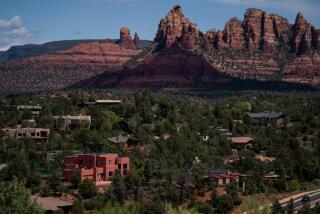TOURISM : N. Dakotans Rolling Out Welcome Mat : It could be a tough sell, but officials are planning to extol state’s virtues in order to attract visitors.
- Share via
BISMARCK, N. D. — A raw, sleet-filled wind drove across the plains, pushing the windchill factor down to the misery level, and there was Jim Fuglie--a plaid-shirted bundle of optimism--laying plans to extol the virtues of North Dakota to the nation’s tourists.
Although Fuglie would not agree, his job as the state’s director of tourism is formidable because North Dakota is a tough sell: It is flat as a checkerboard, wickedly cold in winter and, well, simply a place a lot of motorists hurry through, stopping only for gas. His promotion budget is $2 million, less than any state but Nebraska and Delaware.
Rand McNally once even forgot to include North Dakota in one of its maps. Newsweek magazine called it part of the American Outback. A pair of Eastern academics suggested abandoning most of it and turning the Great Plains into a “Buffalo Commons.” And when Fuglie conducted a survey in Minnesota and asked people what the first thing that came to mind when North Dakota was mentioned, the predominant response was no response. Almost everyone drew a blank.
But tourism is increasingly important here in trying economic times, as it is in all the Mountain States, and since Fuglie took over six years ago, North Dakota has brought its marketing strategies in line with reality and seen its tourism industry grow by 8% a year. Last year, 2 million visitors--many en route to someplace else--spent $390 million in North Dakota.
“We don’t delude ourselves that we’re a destination for national travelers or that we’re going to have people lined up on our borders trying to get it,” Fuglie said. “but if we can get three or four days out of, say, a two-week Western-destination vacation, then we can have an impact.”
North Dakota has pulled all its advertising out of the national market and concentrated on a neighborhood audience, particularly in Minnesota and in Canada, whose citizens come in droves for a day or two to take advantage of lower prices, Sunday shopping in covered malls and motels with swimming pools. Fuglie’s goal is to attract 3 million visitors annually within 10 years.
Even the outback image that used to make North Dakotans cringe is now accepted as a mark of uniqueness that can be capitalized on. “If anything, we’ve suffered for years with the attitude that we had nothing to offer,” said Pat Ness, president of the foundation that has restored Gen. George A. Custer’s home and the 7th Cavalry headquarters. “Now, I think, our inferiority complex is showing a little less and we’ve started saying, ‘What we have here is really special.’ ”
The tourism department--which once put up a tongue-in-check billboard informing tourists that North Dakota’s “mountain removal project” had been completed--now entices visitors with campaigns touting the Custer home, historical sites from the Lewis and Clark expedition, wildlife refuges, the largest buffalo population in the United States, national and state parks and Lake Sakakawea.
“Look at how Australia has capitalized on its outback image,” said Jay Scherbenske, a Bismarck businessman. “That’s the very thing a lot of Americans are looking for now and we’ve got it--open spaces, clear air, a new region to explore. We may not have crocodiles, but so what? We’ve got mountain lions.”
Scherbenske and several other businessmen have plans to promote North Dakota and the surrounding states as the “Great American Outback.” They hope to market Dakota-made food, clothing and crafts and to publicize the region as a tourist destination.
“I don’t like to brag about what we’ve got in North Dakota,” he said, “but even in winter, if you’re looking at kicking back and putting up your feet to read a book, I can guarantee you there’s nothing more warming than to be by a hearth when the wind’s blowing and it’s 40 below outside.”
More to Read
Sign up for The Wild
We’ll help you find the best places to hike, bike and run, as well as the perfect silent spots for meditation and yoga.
You may occasionally receive promotional content from the Los Angeles Times.






